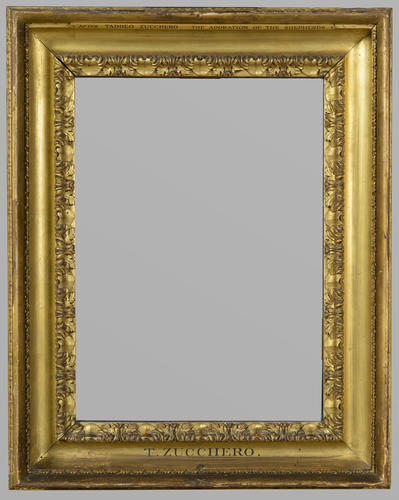-
1 of 253523 objects
Frame for RCIN 405501, Flemish School, The Adoration of the Shepherds second half 18th-century
Carved and gilded | 55.1 x 44.1 x 7.1 cm (frame, external) | RCIN 7405501

British School, 18th century
Frame for RCIN 405501, Flemish School, The Adoration of the Shepherds second half 18th-century
-
This style of frame, known as Carlo Maratta, is ubiquitous in many British collections. These relatively simple frames were favoured in Roman picture galleries in the eighteenth century and were probably left on paintings as they were sold and entered foreign collections. The style was especially popular with British collectors and was copied for decades after. The name is derived from the Italian Baroque painter Carlo Maratta (1625-1713), whose works presumably first arrived in London in such frames.
The distinctive ‘Maratta’ ornament typically consists of a band of acanthus leaves and tongues or shields on the sight edge (nearest the picture surface) or in the front hollow (main curve of the frame); this can be enriched by pin-and-twisted-ribbon ornament, beading, or gadroons (teardrops). The profile of the frame is also easily recognisable - it has a deep front hollow and outward-curving top edge.
This style was chosen by George III to frame his contemporary acquisitions by artists such as Zoffany and Gainsborough as well as earlier, often Italian, paintings already in the collection. Other fine examples can be seen on a group of pastel portraits by Liotard commissioned by Augusta, Princess of Wales in 1754 (eg RCIN 7400892) and for which the artist also arranged the framing. The style appears in a more sophisticated form, with fine carving and more complex ornament on a number of portraits and history paintings by Benjamin West which were commissioned by George III c. 1771-79 – these frames can possibly be attributed to leading London frame maker, Thomas Allwood (c. 1738-1799) (for example RCIN 7404574).
Smaller paintings acquired by George III in 1762 from the collection of Consul Joseph Smith arrived in their Venetian panel frames, whilst the larger paintings (many by Canaletto and Zuccarelli) may have travelled unframed or with some sort of temporary protection. On their arrival they were set into Carlo Maratta frames, and some were hung in the Entrance Hall (now the Marble Hall) at Buckingham House. During the reign of George IV, a number of these were moved to the Grand Corridor and State Apartments at Windsor Castle. In around 1828 they were extended with Rococo corner composition ornament additions to create a grander effect more in keeping with the other more substantial frames in the Grand Corridor. The effect can be appreciated in Joseph Nash’s watercolour of the south end of the Corridor (1846, RCIN 919782).
-
Creator(s)
(framemaker) -
Medium and techniques
Carved and gilded
Measurements
55.1 x 44.1 x 7.1 cm (frame, external)
55.1 x 44.1 x 9.3 cm (frame, external, + buildup)
39.5 x 28.5 cm (sight)
8.0 cm (Width) (frame, section)
Category
Object type(s)